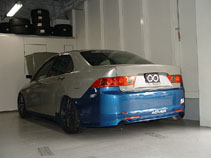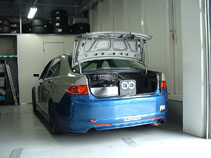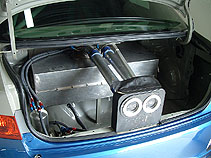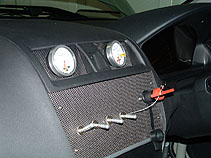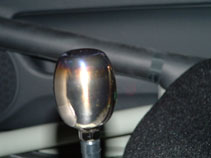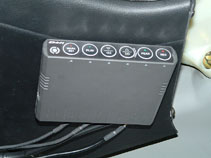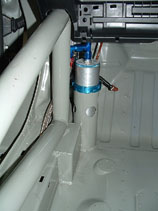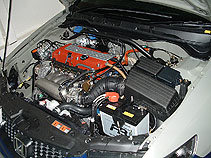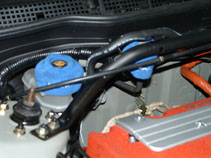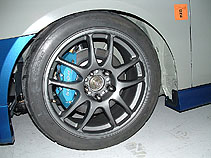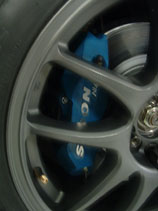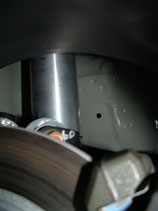

Spoon Endurance Accord Euro-R
I
don't know if this represents a scoop of some sort or not, but here it
is then, the photos from my close-up check of the Spoon Endurance Racing Accord Euro-R
. As I described in my main article on my Spoon visit, Ichishima was very excited
about this, his latest racing project. Two of these cars were being built at the time of
my visit, one for the JDM circuit and one to be used to compete in a '25-hours' endurance
race in the United States on December 7th 2003. I apologise for being too excited
to note down the name of the race so perhaps my U.S. readers might do us a favour by checking
out for a '25 hours endurance race' for the date mentioned.
Competing in the U.S. endurance race makes Spoon one of a selected group
of japanese aftermarket tuners to have expanded their racing efforts outside of Japan.
It's like I said in my main article, this moves shows that Spoon has taken the next
step forward : First your City, Then your Country, Finally the World and thus Spoon
has taken the step forward to compete in the worldwide professional racing scene.
Just a few interesting annecdotes from my interview on this car. I
specifically asked Ichishima why he chose to field the CL7 Accord Euro-R instead of more
'logical choices' (to us enthusiasts, that is) like the DC5 Integra Type-R or the
EP3 Civic Type-R. After all, those who have been following the BEST MOTORing/HOT VERSION
videos knows that stock-to-stock, the DC5 and the EP3 are very much faster than
the CL7 (Accord Euro-R) on the race-track. However, Ichishima's answer took me by surprise.
He doesn't think the DC5 is as good a base as the CL7. In fact, he admits to be unimpressed
with the DC5 as a base for modifications. 'It's based on a van', he says, 'it's a Stream
Coupe !'. Similarly the EP3 to him is a 'Stream hot-hatch'. The CL7 Accord Euro-R to
him is the best all-round current generation Type-R model made by Honda.
Controversial though Ichishima's statements are, let us take a closer
look at the reasons. In many ways the design profile for the Stream was the base for the
DC5. The K20A engine first appeared in the Stream before being tuned for the DC5. Furthermore
the biggest discussion point amongst enthusiasts was Honda's decision to discard the
double wishbone suspension for the front, replacing it with the MacPershon strut design.
However the DC5 was specifically designed from scatch (using the same base as the Stream
though) to be an all-out FF performance coupe. Many of the DC5's features are things we
enthusiasts holds important : Recaros, 2-pot Brembo calipers, Chrome-Moly flywheel, etc.
But Ichishima's response to these is that he feels some of us may have been too enticed
by these features. He confess to a fondness for the old DC2 Integra Type-R and that the
B-series engine, especially the B18C SpecR is to him still one of the all-time best engines
Honda has ever made.
Now, before we go into a debate over Ichishima's statements above, I need
to point out the 'difference in culture' factor that I highlighted in my main article. Again
here is where I feel a difference in interpretation in language is at play. I had a rather
long discussion with Ichishima and my personal opinion is that Ichishima does not mean to
say that either the DC5 or the EP3 are bad cars. Indeed I do believe he thinks highly of
these models - he parks a 'Spoon DC5' right in front of his Type-One head office. I think what
he actually means is that the CL7 has a higher potential for modifications - he was probably
able to extract a higher performance level from it than either the DC5 or the EP3 for
professional level racing. Indeed
in recent HOT VERSION videos, both the DC5 and EP3 were not able to take on a modified
Toyota MR-S that had an engine swap from the Celica. And the MR-S took the DC5 and the
EP3 due to its much better handling. I think this is not due to the FF configuration rather
more that the MacPershon strut may have limitations for all-out modifications for performance.
By comparison, the CL7 Accord Euro-R retains the more desirable double wishbone suspensions
for both front and rear. Stock-to-stock, the CL7 loses to the DC5 & EP3 mainly due to its
inferior power-to-weight ratio (being around 200kg heavier) but of course for competitive
endurance racing where cars are stripped bare and minimum weights are enforced, this biggest
archilles heel of the CL7 Accord Euro-R is no longer of any significance. Therefore
personally I can see why Ichishima chose the CL7 Accord Euro-R as his base car for his
US endurance challenge.
For my 'photo album' below, click on the icons for the larger sized
photo. I have made all of them standard VGA resolution at 72 dpi. Most of the large photos
are around 100kBytes in size just to give you an idea of how long each will take to load.
As usual, I have put my personal observations where applicable. I hope you enjoy checking
out Ichishima's Accord Euro-R as much as I have !
|
|
|
|
| I still feel the JDM
Accord looks better ! |
Japanese Racing cars
frequently features this special refueling system |
|
|
|
|
|
The shift-knob is
polished & lightened |
|
|
|
|
|
| The compressed air
operated four-point integrated jack system allows quicker pit-stops. The
roll-cage is also carefully integrated into the chassis. |
|
|
|
|
| The engine
bay is the highlight of the car featuring the oil-catch tank (2nd photo) and
Spoon 'socks' (3rd photo) to insulate the brake and clutch fluid reservior. Spoon
uses Motul. |
|
|
|
|
| Spoon's 2-pot
brake calipers are used for the front while the side mirrors features generous
amounts of carbon fibre. I didn't find out what shocks were used on the car though.
|
Previous Article in this series : TOVA Visits SPOON in Tokyo.
Wong KN
November 2003
© Temple of VTEC Asia

